Trans Balkan XXL – Cycling home from Patras to Munich
by Ingrid Wolf
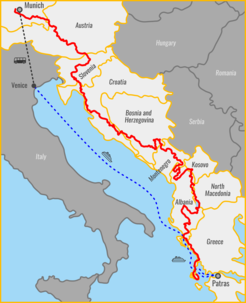
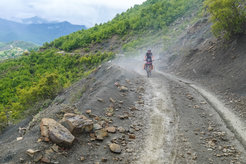
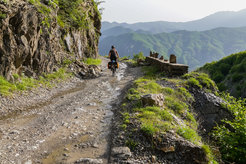
After quitting my job at IMPRS, I was asked many times: “When are you starting your trip around the world by bike?” Well, we (me and my husband Bernard) knew it wasn't going to happen any time soon, but of course we wanted to start another long bikepacking trip in spring 24. After weeks of intensive planning, we finally were ready to go. Cycling through the “Balkans” along the Dinaric Alps, a destination we had been dreaming about for a long time, would be the adventure for the next 2-3 months!
End of April a Flixbus brought us and the bikes from Munich to Venice where we rolled onto a ferry to Patras in Greece. After a short stopover, another ferry finally took us to Sami, a small village on the Ionian island of Kefalonia. In this way, we reached the actual starting point of our bicycle tour after almost four days in a rather “slow”, but eco-friendly and relaxing mode. Greece welcomed us with sunshine, blue skies and first dips in the cold and crystal-clear waters of the Mediterranean Sea. This was part of the plan to start in the south with warm temperatures and follow the arriving summer in all countries we will cross on our way north. A clever plan, wasn’t it?



As we both love mountains, we had to cycle up the highest mountain of Kefalonia, Mount Ainos (1628 m). A steep gravel road through forests with endemic fir trees was our first challenge, rewarding us with an incredible view from the top. From Kefalonia we hopped over to Lefkada and from there we followed the coast to the border with Albania. Cycling in Greece was easy, small and mostly quiet roads and many supermarkets to stock up on food. With crossing the Greek-Albanian border in pouring rain many things changed and the Balkan adventure really started: cycling on rough gravel roads and no big supermarkets, just tiny markets with a very limited selection of groceries. But it really is amazing how fast one can adapt to new challenges, being happy to find a fresh loaf of bread in a “Furrë buke” and cucumbers, tomatoes and pasta. All very simple but totally sufficient.
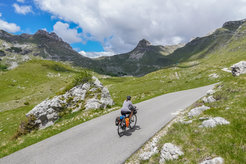

We cycled several loops through Albania. The route of the first loop included visits of busy and more touristic places such as the UNESCO world heritage sites of Butrint and the historic centers of Gjirokastër and Berat. All very nice but we enjoyed more the secluded places such as the muddy mountain pass from the Vjosa to the Osum valley, the Osum river canyon and especially the impressive canyon of the Devoll river. In Pogradec we arrived at lake Ohrid, the second largest lake in the Balkans and the oldest lake in Europe. After crossing the border to North Macedonia, we cycled along the eastern shore of lake Ohrid and followed the river Black Drin to Debar. After only two days we went back into Albania.

The route of the second loop took us through the remote and very poor eastern part of Albania. The absolute highlight was the hike up to Mount Korab (2764 m), the highest mountain of Albania and North Macedonia. Here, we felt overwhelmed by the beauty of nature and absolute wilderness. We crossed meadows covered with yellow crocuses and found fresh bear tracks in the snow! From Kukës it was not far to our next border crossing. We cycled a tiny loop through Kosovo, our 4th country. The route via Gjakova was not the most exciting, however, on our way we rescued several turtles from being run over by cars.
Back in Albania, we started the third and final loop which included a pleasant ferry ride on lake Koman, a visit of the cities of Shkodra and Tirana and finally we spent some time in the North Albanian Alps to ride some tough gravel roads and go hiking again. We truly fell in love with Albania, the incredible friendly and welcoming people and the amazing nature. The most common car in Albania is a German “Mercedes”, and it is present in all existing models from 40 years old to brand new. How can some afford buying a new Mercedes whereas almost all work in the fields is done by hand (there are hardly any tractors!)? The contrasts in this country are huge: modern houses next to many post-communist ruins or one of the 750,000 bunkers which were built during the government of dictator Enver Hoxha; beautiful nature struggling with insane amounts of plastic waste because of the absence of a functional waste management system, just to mention a few.

After nearly three weeks in Albania, it was time to cross the border of our 5th country, reaching Montenegro. Its name “black mountain” says it all, the entire country is very mountainous. First, we cycled along the river Lim, then we crossed a mountain range over an off-road pass to hit the Tara valley in Kolašin, an important winter sport resort with an interesting post-Yugoslavian atmosphere. Arriving in town we realized that all shops were closed due to two national holidays. A hit and a big mistake! We didn’t check beforehand. Usually, we always carry some extra food for emergencies, but guess what, this time we had nothing left in our bags. Luckily, one restaurant was open that evening and one bakery the next day in the morning. A little hungry, we continued our route through the Tara River gorge, the longest and deepest canyon in Europe, and went straight into the fantastic Durmitor National Park (NP). As we couldn’t get enough of these beautiful landscapes, we climbed the summit of Bobotov kuk (2522 m), the highest mountain of Montenegro. After a cold night in the “1000 stars hotel”, our beloved tent, we celebrated the descent over 1500 meters of altitude towards the border with Bosnia and Herzegovina. We really enjoyed the beautiful landscapes in Montenegro, however from the Tara River up to Žabljak we experienced the most reckless drivers of our entire trip.
Do you remember the “clever plan” which I mentioned in the beginning? I have to admit that this didn’t work out at all. We already had some rain since we entered Albania, but with crossing the border of our 6th country, Bosnia and Herzegovina (BH), the weather changed a lot. It was raining almost every day and temperatures dropped until we were back in Germany. But hey, no reason to change plans, just more serious testing of our equipment and our mental strength!
First stop in BH was the city of Foča, from where we continued via a long gravel section through the Sutjeska NP and over the Zelengora mountain range until we reached Mostar with its famous bridge “Stari most”. Mostar’s historic center is beautiful but packed with tourists. Therefore, we quickly continued on challenging gravel roads through wonderful, remote karst plateaus, past the lakes Blidinjsko jezero and Buško jezero and next to colorful meadows full of blooming flowers. We experienced BH with kind of mixed feelings: gorgeous nature on one side but many places where all the damages from the war in BH (1992-1995) are still visible on the other side. Almost all people we had contact with are still traumatized and for us it seemed that the existing conflicts between the different ethnic groups are not solved, but only frozen for the moment. In BH, however, we had many wonderful encounters, e.g. with an old man who distilled rakija from apples in his garden using an interesting home-made setup. Of course, we had to try several shots, and at the end, he said goodbye by giving us a small bottle of rakija.

By crossing the border of our 7th country, Croatia, we were back in the European union (EU). The landscape continued to be characterized by karst. We visited the “eye of Croatia”, the spring of the river Cetina. Throughout the Balkans we saw several “blue eyes” but the spring of the Cetina and of the Buna in BH were the most impressive. Mount Dinara (1831 m) was close to our route, so we had to climb it not just because it is the highest mountain of Croatia but also because it is the name giver for the Dinaric Alps, the mountain range we followed up and down for the past weeks. We stayed inland and crossed the entire mountain range of the Velebit NP. The vast forests are the perfect home for brown bears. They live in all mountain regions we have visited so far, but in the Velebit and even more so in Risnjak NP and the southwestern parts of Slovenia, the density is the highest. We didn't see any bears, but we did see bear droppings on the road several times and one night we heard a bear grumbling close by. From that point on we didn't feel so comfortable anymore camping in the wild (we did it anyway!).
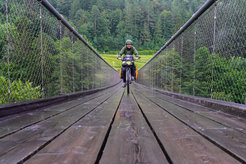
Being in the EU you hardly notice when you roll into the next country and for us that was country number 8, Slovenia. But still every country is unique. Here too, we were amazed about the natural wonders created by karst. After a guided tour of the cave Križna jama, we visited the karst lake Cerkniško jezero, whose water disappears underground in summer, and the impressive gorge Rakov Škocjan which was created by the collapse of a cave ceiling over a river. After a nice break in the lovely city of Ljubljana, we were confronted with very rainy weather and in parts too much traffic. In addition, our 9th and 10th countries, Austria and Germany, just felt too familiar. Therefore, we speeded up a bit and finished our tour a bit earlier than planned.

After eight weeks, 3300 kilometers and 45000 meters of altitude cycled, we were back home. It was an amazing trip. Every day was different and the only things we had to think about were: Where will we get food? Where will we get drinking water? Where are we going sleep tonight? This minimalistic and simple life is pure freedom and we are already looking forward to the next bikepacking trip.
A more detailed report can be found on our website: https://blog.maiwolf.de/
About the author
Ingrid studied Biology at the Julius-Maximilians-Universität Würzburg and the Ludwig-Maximilians-Universität München (LMU). She completed her doctorate in biochemistry at LMU and worked as a postdoc at the Fred Hutchinson Cancer Research Center in Seattle, USA. She took a break from work to raise her two children Katharina and Sebastian. In March 2009, she started as a scientific coordinator at IMPRS-LS, transferred to IMPRS-ML and finished her job in December 2023. She is addicted from bikepacking but also enjoys hiking, ski touring, sea kayaking and spending as much time as possible with her familiy.












